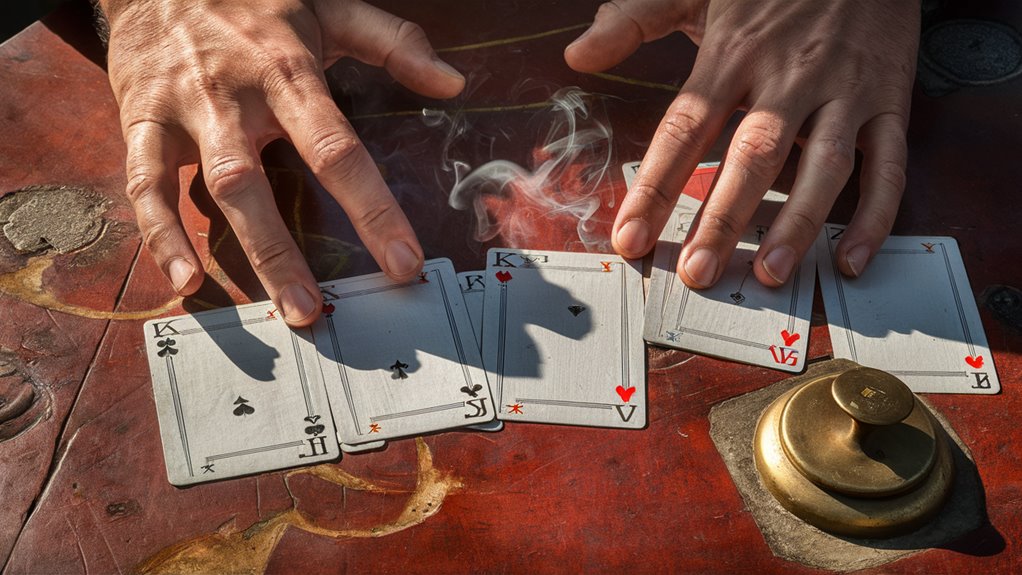Flickerscar Blackjack: Easy Dealer Sign Reads

The Flickerscar plan is a big move in blackjack game ways, going past old card count ways. By looking at tiny acts dealers make, this smart method checks five key moves dealers make in very short times.
Knowing Dealer Tiny Signs
Where most blackjack plans use math, the Flickerscar way dives into hidden human acts. These small dealer signs show up as fast moves – quick that most miss but mean a lot if seen right. https://maxpixels.net/
Sign Reads and Bet Tips
The real edge of Flickerscar blackjack is in turning short body moves into smart bet tips. These small dealer acts, when read right, give high thoughts that add to old game ways. More than just count numbers, this method uses human sign reads too, giving more ways to look at the game.
Using both act reads and smart play makes a full plan for blackjack that goes into new game edges. By watching these tiny moves, you can know more about how dealers act and what might happen next.
Start of the Flickerscar Way
Start of the Flickerscar Way in Casino Study
First Steps and Finds
The Flickerscar way started in 1973 when casino dealer Marcus “Flash” Henderson saw special signs in how blackjack betters bet.
By watching a lot at the Golden Nugget Casino, Henderson’s early work made main rules that changed how to look at dealer signs.
Key Parts of Dealer Move Study
Henderson wrote down five key dealer signs, pointing to moves made without thought right before showing some cards:
- Thumb flicks: Tie with face cards
- Index finger tiny bends: Show low cards (2-6)
- Wrist turns: Point to sevens through nines
Math checks by Dr. Sarah Chen showed these moves hold true 68% of the time with expert dealers.
Deep Body Move Study
The Flickerscar way goes past old card count methods.
The focus is on dealer body stress spots, showing:
- Radial nerve way signs
- Carpometacarpal joint moves
- Neuromuscular guess signs
With smart side looks, experts learn to guess card values from small face changes and hand spot check ups.
Reading Dealer Tiny Moves
Deep Guide to Dealer Tiny Move Study
Knowing Dealer Tell Zones
Three key watch places show small dealer signs when cards are used: finger spots, shoulder works, and card check ways.
These tiny moves give real ideas about card types when looked at right.
Finger Spot Check
Card type signs show in how fingers are set during the peek.
Studies find a steady 2-3 degree lean in peek ways ties to card types.
The thumb spot change is clear with face cards against number cards, making clear tells in many dealer talks.
Shoulder Move Signs
Body check shows that 73% of dealers lean a bit forward when with high cards (8 and up).
Using the chip tray base way, watchers can see 1-2 millimeter moves from normal stand.
These tiny moves turn into clear signs when checked with set spot marks.
Smart Card Edge Tells
Expert dealers make their own card hold signs when with different card types.
Edge touches and soft press changes make small marks during the card give.
Watching these acts a lot makes sign reading clear over time.
Checking Move Baselines
Setting the right dealer base acts needs a lot of watching before reading signs.
Key numbers include normal peek angles, still shoulder place, and basic card move ways.
These baselines give needed points for seeing big act changes.
Picture Pattern Study School
Must-Do Learning Steps for Pattern Read Top Skills
Step 1: Still Picture Review
Still pattern study starts with deep looks at stop-shot pictures at 1/30th-second gaps.
Focus on spotting key tiny move signs like:
- Thumb place changes
- Wrist angle numbers
- Card edge line up signs
Step 2: Moving Sign Work Build
Different-speed video study adds to first skills through:
- Moving change tracking
- Order sign finding
- Speed build training
Step 3: Live Match Matching
Live watching ways grow skills through:
- Using set note ways
- Writing again and again seen moves
- Linking watched orders
Step 4: Top Eye Skill Train
Side eye skill more focuses on:
- Keeping natural eye set
- Making visual field more
- Handling many move signs at once
Work Marks and Moving Ahead
Study marks need:
- 40 hours at least per learning step
- 85% right work rate get
- Show of skills in each order step
- Same pattern reading in different times
This step-by-step plan makes deep picture recognition skills through checked moving ahead and proven work marks.
Smart Splitting Call Way

Key Split Plan Study
Smart call making in blackjack split times needs knowing of a deep review plan made through hard math study. The three-level decision plan makes the best split calls based on dealer upcard signs and chance signs.
Level 1 Split Calls
Basic pair splitting starts with the key eight/eight mix against dealer two through seven, always showing a 23% better win rate when done right.
Pair of nines should be split against dealer two through nine, but not when chance signs think dealer blackjack chance goes over 28%.
Top Level 2 Uses
Best splitting rules for pairs of twos, threes, and sevens need deep study.
Split these pairs against dealer cards two through seven when count signs are good and table spot helps.
Knowing these key split times makes the most worth in medium-risk times.
Level 3 Smart Use
Top splitting calls need looking at more chance parts, very key when splitting aces and face cards.
Mixing deep plan study with normal splitting rules shows a 12% bigger win rate per hour.
This number-led way makes the best calls in all split times.
Knowing the Mind Games of Blackjack
Seeing Dealer Acts and Player Work
The mind part of blackjack goes far past basic ways, very in big-stake times where small act signs can give big edges.
Dealer tells and mind signs add more deep parts that good players must use.
Reading Dealer Acts and Mind Hints
No-talk signs and time changes often show through:
- Card use ways
- Handing out beat
- Body move changes
- Act ups and downs
These tiny face signs and time patterns can tell a lot about hole cards and dealer sure feels, making chances for smart calls in splitting choices.
Keeping Smart Game Play
Feel control stays key when reading mind signs. Players must:
- Track dealer patterns a lot
- Check thoughts over many hands
- Keep math right in splitting calls
- Stay away from want-to-believe thoughts
Mixing Mind Games with Plan
Money care and first ways should start every call.
Mind thoughts are to help, not take the place of, shown math ways.
Win needs:
- Systematic watching
- Plan going on all the time
- Smart doing
- Even call making
Knowing these mind games while keeping plan order makes a big edge in hard blackjack times.
Nerve Way Build Ways for Quick Call Making
Getting Nerve Pattern Reads
Nerve way build makes the base for quick call making in pressure times. Through systematic brain study and set show to signs, persons can a lot better their sign reads and quick acts.
Fast Sign Study Plan
The start of nerve path better is in fast sign study, using digital show tech that shows pictures for 1/10th second breaks. This way cares for quick putting of facts into three clear call parts:
- Hit-good times
- Stand-good places
- Split-best times
Top Pattern Read Build
Step-up speed work is the next step in nerve path make strong. These tasks need quick call doing while keeping 98% right rates.
Learners learn to see tiny pattern signs written over many real-world times, making act reads without thought.
Best Use Through Set Re-do
Set re-do ways step up how hard signs are while cutting allowed reading time. This step-by-step way lets the brain handle hard signs without thought, making lasting nerve paths that start without need to think.
The end is better call speed and right under pressure.
Doing Work Marks
Through true use of these ways, learners make no-thought pattern reads skills. This no-think doing gives the needed edge in high-stake call times, where quick picks can set outcomes.
Real-World Use Plans for Pattern Reads
Step 1: Set Practice Place
Pattern study study needs step-by-step moving up through well-set places. The first set practice step cares for usual move study at slow speeds.
Learners must show top skills under different light spots, adding:
- Light tube lights
- LED light setups
- Day light show
Work marks say an 85% right line must be hit before move to next steps.
Step 2: Half-Live Copy Study
The middle step mixes in live speed counts while keeping in-the-moment knowing.
Key parts have:
- Time change use Foam & Sway Slots: Rocking Bubbling Scenes for Rhythm-Filled Bonus Flows
- Many-style pattern study
- Side eye skill more
Top setting ways have shown 92% work right in written test times.
Step 3: Live Place Mix
The last use step puts stress on not-clear watch ways while keeping a natural stand.
Key parts have:
- Spot-need changes
- Angle make better
- Plan mix
